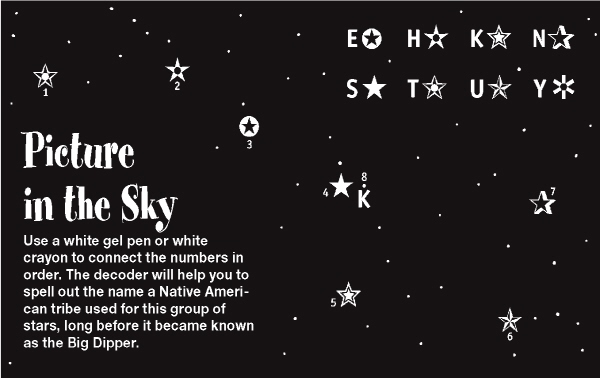Everything Kids' Astronomy Book (6 page)

Just for Fun
Indoor Night Sky
To make an indoor sky, take a large piece of black plastic and draw the night sky on it with a silver paint pen. Use a pencil tip to make a hole for each star in the plastic so your stars will shine from the light outside. Tape the sky over the open end of a large appliance box. You will need a door in the box to get inside.
Diamonds in the Sky
When it starts to get dark each night, which are the first stars you see? The brightest ones, of course! Over 2,000 years ago, Hipparchus developed a numbering system, one through six, based on the apparent magnitude or brightness of the stars he saw from Earth. A first or number one magnitude star was 100 times brighter than the faint stars in the sixth class. Over time astronomers have found some objects can be brighter than a one, so they started using a minus sign to indicate how much light there seemed to be. Do you think there are numbers higher than six? With modern telescopes, stars can be listed up to a thirty! Hip-parchus might have been surprised to see astronomers still use the information from his catalog today. Newer books have changed the amounts of a few of his numbers and many, many more stars have been added to his list. Suppose you and your friends are walking after dark and you see a light shining in the distance.
WORDS to KNOW
MAGNITUDE:
The amount of light a star emits or gives off is called its magnitude. Astronomers measure the magnitude of the stars out in the universe by using a number system.
It could be a streetlight or a flashlight. How bright it is doesn't tell you much about the light, if you don't know how far away it is. Modern astronomers have learned how to measure the distance to a star and its apparent magnitude, or how bright it appears to us. They use both of these figures to determine the absolute magnitude or luminosity (true brightness) of a star. Scientists pretend that the sun and the other stars are all the same distance from the earth to figure their absolute magnitude. The sun has an apparent magnitude of â26.7 and absolute magnitude of 4.8. See what a difference a little distance makes!

Connecting the Dots
Have you ever seen what looks like animals or people hiding among the stars in the constellations? Ancient stargazers like the Chinese, Egyptians, Greeks, and people living in the Middle East saw some of these same creatures. Some believed they were gods and made up wonderful stories about them that are still retold today. Each of these groups of people had different names for the same clusters of stars or constellations. Sometimes some parts of one constellation were grouped with part of another, and many were never seen because none of the stargazers lived in the Southern Hemisphere. You might not be able see all of them, either. Eventually it was agreed that there were eighty-eight constellations in all, but many of the shapes had been changed. Do you really think Cygnus looks like a swan or Canis Minor and Major look like a pair of dogs? Although the stars that form the figures appear to be close in certain constellations, they may actually be billions of miles apart. And because they are moving, they might be in other constellations eventually. Like the imaginary celestial equator above Earth that helps astronomers locate objects in space, there is also an imaginary circle called an ecliptic. This circle is where the eclipses of the sun and the moon occur. Some of the constellations seem to move along this circle. This circle swings from 23.5 degrees north of the equator to 23.5 degrees south of the equator as the earth orbits around the sun. Would you call the Big Dipper a constellation? To most astronomers it is an asterism, or just part of the constellation known as the Great Bear or Ursa Major!
WORDS to KNOW
CONSTELLATION:
A constellation is a group of stars that together form an image in the sky. One constellation that is well known is Orion.
How the Constellations Got Their Names
Have you read a lot of fairy tales or watched them on TV? Most of these stories were written for children to enjoy, but they were also written to teach children good behavior and keep them safe. Their lessons were things like: don't talk to strangers, be honest and kind or you might be punished. Ancient storytellers told stories about what they thought they saw in the sky, from mighty hunters like Orion to magical animals like unicorns and winged horses, or even things like a harp and a cross.
What's Your Sign?
When people talk about constellations, do you think about the twelve symbols listed in the zodiac? Many people do because it's fun to talk about astrology. The history of astrology goes back for thousands of years, and there is more than one type of astrology. In some cases the month when you were born is what counts while others rely more on the year you were born. Depending on what year you were born you may be under the sign of the rat or the monkey, or one of the other ten animals. Some people still believe that the date of your birth has an effect on your life. As the earth orbits the sun, several constellations are visible in the night sky for about a month right along the ecliptic circle. The sign in the middle is considered the dominant or main sign. In the monthly astrology, if you were born in the first part of the month of March, Pisces would be your sign. The sun, the moon, and the planets all appear to move through these special constellations during the course of the year. Maybe you have heard of some of the signs like the crab or the twins. If you think you might want to use astrology to predict your future, remember all of the changes that have been made in the calendars over the years. March 5 was probably January 21 thousands of years ago.


WORDS to KNOW
ASTROLOGY:
Astrology is a belief that stars and other objects in space can be used to predict future happenings or events. People who are born under certain signs are expected to display certain characteristics and qualities.
What's a Planetarium?
Have you ever been to a planetarium? As the lights dim in a large dome-shaped building, the presenter starts the projectors that create the images of the many wonders in space. In some planetariums as the displays change, you can hear the sound of gears moving. Astronomers living around 2,000 years ago used similar gears in some of their simple machines. These machines were used to predict eclipses as they moved the models of the sun and the moon around. Some scientists believe they also showed the paths of the planets. As the show in the planetarium goes along, you soon see the star-filled sky displayed over your head; it changes to show the seasons of the year and the hemispheres on Earth. Going to a planetarium is sort of like climbing into a time machine as it shows you what the sky used to look like and how it might look in the future. You can even experience what it would be like to travel in a spaceship throughout the universe. Wouldn't it be great to have someone to point out the locations of these different stars when you are in your own yard? Learning where to look for constellations and planets is as simple as taking a trip to the planetarium, buying a planetarium program for your computer, or going on the Internet to look for star maps at
Skyan-dtelescope.com
.

WORDS to KNOW
PLANETARIUM:
A planetarium is a special building designed to display all the wonders of the solar system and outer space to an audience.
Double Trouble
Did you ever wish that you had a twin? You probably wouldn't care if they didn't look exactly like you, as long as they were always there when you needed a friend. Astronomers believe many of the stars have twins. Sirius A, the brightest star in the sky, has a white dwarf companion about the size of Earth, called Sirius B. You might be wondering how astronomers decide if one really bright star is actually two? They look to see if part of the star seems to be blue or coming toward them while the other half is red or moving away. Alpha and Beta Centauri are close enough together to appear as one really bright star, but they are actually triplets if you include Earth's nearest neighbor, the faint Proxima Centauri. Other binary or twin stars are discovered because once in awhile they eclipse each other just like the moon does the earth.
Twin Stars

Can you find the seven differences between this pair of twin stars?

